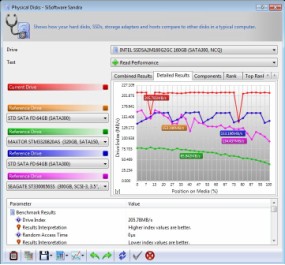Intel 34nm X25-M Gen 2 SSD Performance Update
Our Test Methodologies: Under each test condition, the Solid State Drives tested here were installed as secondary volumes in our testbed, with a standard spinning hard disk for the OS and benchmark installations. The SSDs were left blank without partitions wherever possible, unless a test required them to be partitioned and formatted, as was the case with our ATTO benchmark tests. Windows firewall, automatic updates and screen savers were all disabled before testing. In all test runs, we rebooted the system and waited several minutes for drive activity to settle before invoking a test.
|
Motherboard - Video Card - Memory - Audio - Hard Drives -
|
Hardware Used: Intel Core i7 965 Gigabyte GA-EX58 UD5 (X58 Express Chipset) GeForce GTX 280 6144MB Corsair DDR3-1333 CAS 7 Integrated on board Western Digital Raptor - OS Intel 34nm X25-M Gen 2 160GB |
Operating System- Chipset Drivers - DirectX - Video Drivers - |
Relevant Software: Windows 7 Ultimate 64-bit Intel 9.1.1.1019 DirectX 10 NVIDIA ForceWare v191.07 Benchmarks Used: HD Tach 3.0.1.0 ATTO ver 2.41 SiSoftware Sandra 2009 SP4 |
For our SiSoft SANDRA testing, we used the Physical Disk test suite. We ran the tests without formatting the drives and read and write performance metrics taked before and after the firmware update are detailed below. Please forgive the use of these screen captures and thumbnails, which will require a few more clicks on your part. However, we felt it was important to show you the graph lines in each of the SANDRA test runs, so you are able to see how the drives perform over time and memory location and not just an average rated result.
According to SiSoft SANDRA, Intel's firmware update for their 34nm Gen 2 SSDs seems to perform as advertised. Read performance is up slightly but write performance is increased significantly. Before the firmware update, the Intel X25-M offered about ~70MB/s, but after the update that number jumped up to just shy of 100MB/s.










